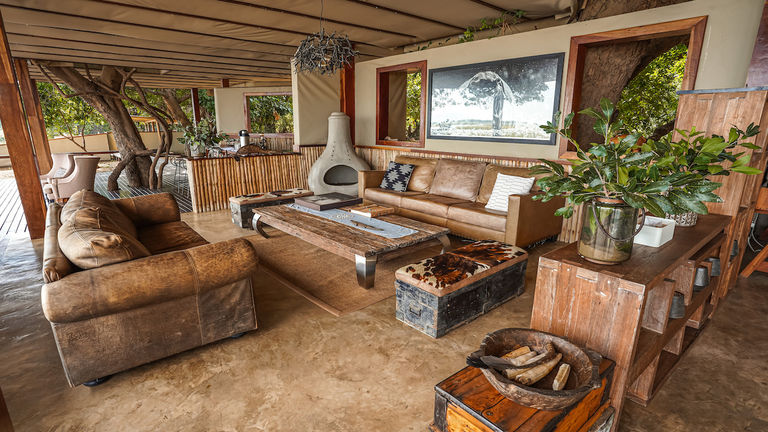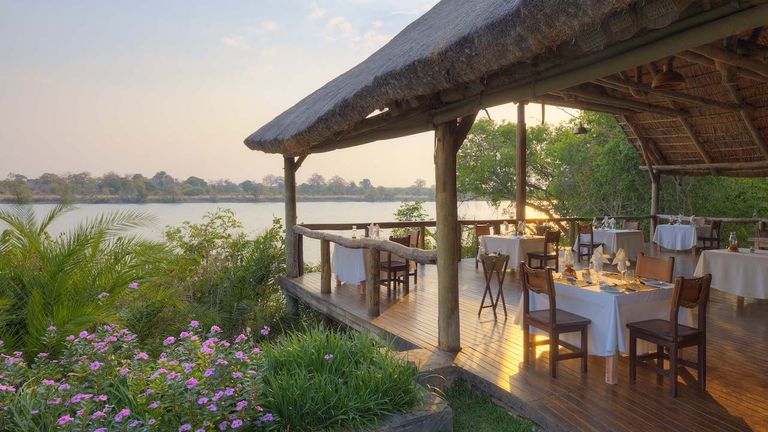Zambia arrived relatively slowly on the safari scene, overshadowed for many years by its more well-known neighbors in southern and eastern Africa. And although it may not be as high profile as Kenya, Tanzania or Botswana, Zambia is touted by those in the know as a magical safari spot; it features some of the best wildlife reserves on the continent and isn't plagued by the hordes that have invaded better-known safari destinations.
The birthplace of the "walking safari” and home to UNESCO World Heritage site Victoria Falls, Zambia has one of the highest populations of leopards in Africa, enormous herds of elephants and is the place to see swamp-dwelling tree-climbing lions — and, of course, a whole lot more.
One of the best ways to see Zambia is with luxury property operator Green Safaris. With seven camps and lodges located around the country, it’s a game-changer for booking clients a safari vacation. Here's what to know about traveling to and within Zambia, and how to adventure in style with Green Safaris.
Flights and Connections
One of the major challenges when planning a Zambian safari itinerary is getting to and from different locations, especially the more remote ones. Driving in Zambia, particularly, is not without its trials: The distances between the various safari areas and national parks are huge, and the roads are often in poor state and hazardous.
In most cases, the easiest way to get around is to fly between parks by light aircraft. Many routes offer fixed schedules but, often, when planning travels away from the main parks, clients will need to charter small planes. Green Safaris can help simplify this process: When you book clients a minimum of four nights at any one lodge, or at a combination of Green Safaris lodges, all internal flights and transfers are included.
South Luangwa National Park
Often referred to as “The Valley of Leopards,” South Luangwa National Park is home to predators such as leopards, lions, spotted hyena and wild dogs; the leopard and wild dog populations are among the densest on the continent. South Luangwa is where walking safaris first began; they were the brainchild of British conservationist and guide Norman Joseph Carr in the 1960s, and they’re a terrific way to view creatures big and small.
If walking isn’t a traveler’s cup of tea, morning and afternoon game drives are an excellent way to see the South Luangwa's wildlife. Clients can head out for a few hours in the morning, then again in the late afternoon; these drives are followed by sundowners before a return to camp on a night drive, where guides use a filtered red spotlight to showcase nocturnal animals.
Shawa Luangwa Camp, open from April to January, is a small and eco-friendly but luxurious bush camp overlooking the Luangwa River. Ideal for safaris on foot and by vehicle, it offers excellent game viewing and knowledgeable guides. Green Safaris pioneered “silent safaris” in South Luangwa, so electric game drive vehicles move so quietly through the park that the wildlife often don’t hear guests coming.
Shawa Luangwa’s five luxury safari tents are located right on the banks of the Luangwa River, and two of the tents being can convert into a spacious Family Tent.
 Tongabezi Lodge is open year-round, and is set on the banks of the Zambezi River.
Tongabezi Lodge is open year-round, and is set on the banks of the Zambezi River.
Credit: 2024 Green SafarisLivingstone and Victoria Falls
Victoria Falls, known also by its traditional name, Mosi-oa-Tunya ("the smoke that thunders"), is one of the Seven Natural Wonders of the World. Its views were described by explorer and missionary David Livingstone as “scenes so lovely must have been gazed upon by angels in their flight.” Behind all this beauty lies some impressive statistics: At 5,604 feet wide, nearly 360 feet tall and with 335,489 cubic feet per second of water cascading over the rim, it’s one of the world’s most incredible waterfalls.
The award-winning Tongabezi Lodge, open year-round, is an eco-lodge just 7 miles upstream of the falls on the banks of the Zambezi River. Combining romance and luxury with a hint of adventure, Tongabezi offers a selection of five river cottages, four houses, and three family houses — each with its own private valet — are beautifully designed and decorated.
Downstream of Tongabezi is the tranquil, off-the-grid Sindabezi Island Camp, a private island open year-round with five open-fronted chalets designed to blend into the wilderness. By daytime, there’s whitewater rafting, helicopter flights, bungee jumping, walking with rhinos and a river cruise. Come evening, clients can relax on their private deck or chat with other guests and guides around the communal fire pit.
One of the best vantage points to witness Victoria Falls is Livingstone Island, located right on the edge of the falls. Both Tongabezi and Sindabezi offer trips to Livingstone Island daily, starting with an exciting boat ride down the Zambezi River to the island, where travelers can swim in Devil’s Pool or Angel’s Pool — infinity pools like no other — and peer over the rim of the largest curtain of falling water in the world. Trips depart five times daily; for Tongabezi and Sindabezi guests, all 2024 lodge bookings include a complimentary Livingstone Island Tour per person.
Lower Zambezi National Park
Lower Zambezi National Park is a relatively undeveloped park, with no paved roads, so it’s rare to encounter another safari vehicle. But although you’ll see few people, you will see herds of elephants and buffalo, plenty of wild dogs and lions, soaring fish eagles and everything in between. Most of the wildlife is concentrated along the river, so a great way to experience the park is by boat or canoe. A definite highlight for keen fishermen is the prized African tigerfish.
 The lounge at Sausage Tree Camp, which offers seven luxury tents.
The lounge at Sausage Tree Camp, which offers seven luxury tents.
Credit: 2024 Green SafarisWith opportunities to explore the park via game drives, on foot or by boat and canoe, Sausage Tree Camp offers a real bush chic experience, with expert private guides and butlers. Open from April to November, weather-dependent, it hosts seven luxury tent suites and one family house; each accommodation comes with a plunge pool, outdoor lounge area and views over the Zambezi River.
Downstream of Sausage Tree, Potato Bush Camp — open from April to November, weather-dependent — is a real value-for-experience safari destination. The three suites and one family house all have plunge pools and are connected via raised walkways, making it a good choice for a family safari.
Kafue National Park
Kafue National Park is Zambia’s oldest and largest of its kind, and it’s one of the continent’s last great expanses of unspoiled wilderness. Kafue doesn’t have the huge herds of game that can be found in other parks, but what it lacks in density, it more than makes up for in diversity.
 The dining room at Ila Safari Lodge, which offers game drives, walking safaris, river cruises and more.
The dining room at Ila Safari Lodge, which offers game drives, walking safaris, river cruises and more.
Credit: 2024 Green SafarisIn the far northwest of the park, the Busanga swamps and adjacent plains are a highlight of Kafue. Much of this northern sector is permanently waterlogged, but in the dry season (May to November) the water recedes, leaving vast expanses of lush grazing — irresistible to an array of wildlife, particularly large herds of antelope.
Solar-powered and built from environmentally friendly, locally sourced materials, Ila Safari Lodge in the central part of Kafue was designed to create only a light impact on the environment without compromising luxury and style. In line with its green ethos, Ila was the first lodge in Zambia to offer electric game drives and river cruises. The newly designed lodge just underwent a complete rebuild and is now open.
In the Busanga Plains, in the northern part of the park, is Chisa Busanga Camp, open from June to November. The rooms were inspired by and mimic the weaver bird nests that decorate the trees here. Sitting on a small tree-lined island, the camp runs on solar power, as do the game-drive vehicles and e-bicycles.